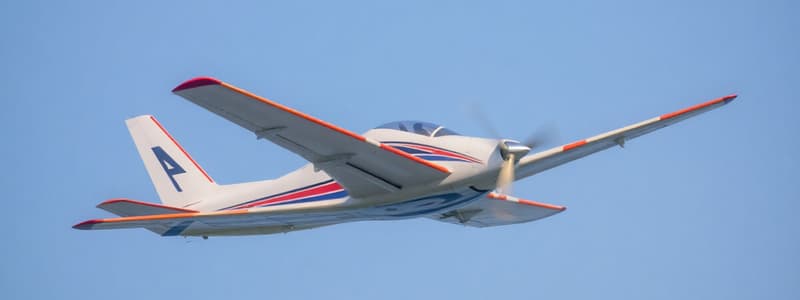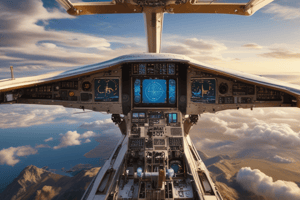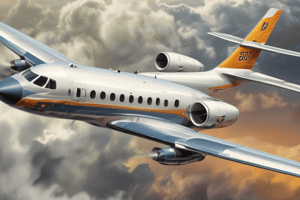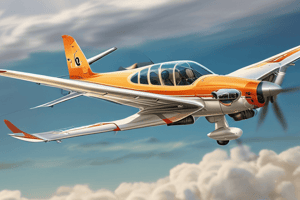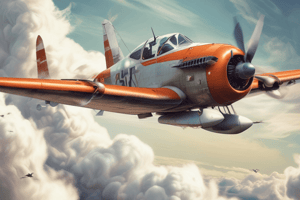Podcast
Questions and Answers
Which factor is NOT typically identified as governing the performance of an aircraft?
Which factor is NOT typically identified as governing the performance of an aircraft?
- Ceiling height
- Payload capacity
- Aircraft color (correct)
- Cruising speed
What is a key performance measure that describes how long an aircraft can operate before needing to land?
What is a key performance measure that describes how long an aircraft can operate before needing to land?
- Range
- Payload
- Endurance (correct)
- Cruising speed
Designers often need to optimize aircraft performance. What is typically a primary consideration in this optimization?
Designers often need to optimize aircraft performance. What is typically a primary consideration in this optimization?
- Achieving minimum performance criteria (correct)
- Reducing overall size of the aircraft
- Using the most advanced materials
- Maximizing all performance measures equally
Which of the following performance measures refers to the aircraft's ability to carry weight?
Which of the following performance measures refers to the aircraft's ability to carry weight?
Which of the following performance aspects is involved in atmospheric modeling?
Which of the following performance aspects is involved in atmospheric modeling?
What is the total take-off distance required for the aircraft to reach take-off speed at a screen height of 35 ft?
What is the total take-off distance required for the aircraft to reach take-off speed at a screen height of 35 ft?
What is the weight (W) of the aircraft given a total weight of 59,000 kg?
What is the weight (W) of the aircraft given a total weight of 59,000 kg?
Which of the following contributes to the total drag coefficient C_D at lift-off?
Which of the following contributes to the total drag coefficient C_D at lift-off?
Calculate the aspect ratio (AR) given the wingspan (b) of 32 m and the wing area (S) of 115 m².
Calculate the aspect ratio (AR) given the wingspan (b) of 32 m and the wing area (S) of 115 m².
What is the total thrust provided by the twin turbofans at lift-off (T_LOF)?
What is the total thrust provided by the twin turbofans at lift-off (T_LOF)?
What formula represents the lift (L) generated by an aircraft in relation to its properties?
What formula represents the lift (L) generated by an aircraft in relation to its properties?
What does the variable $s_{STOP}$ represent in the context of aircraft performance?
What does the variable $s_{STOP}$ represent in the context of aircraft performance?
How does the aircraft's take-off mass (W) affect the distance required for take-off according to the equations provided?
How does the aircraft's take-off mass (W) affect the distance required for take-off according to the equations provided?
In the formula $s_{STOP} = \int_{V_1}^{0} \frac{1}{2g} \frac{W}{\rho S(\mu C_L - C_D)} V^2 dV$, which variable primarily affects the aircraft's deceleration?
In the formula $s_{STOP} = \int_{V_1}^{0} \frac{1}{2g} \frac{W}{\rho S(\mu C_L - C_D)} V^2 dV$, which variable primarily affects the aircraft's deceleration?
Which parameter decreases the stopping distance for an aircraft according to the derived formula for $s_{STOP}$?
Which parameter decreases the stopping distance for an aircraft according to the derived formula for $s_{STOP}$?
What is the importance of the decision speed V1 in the context of take-off performance?
What is the importance of the decision speed V1 in the context of take-off performance?
What is the effect of the variable $BFL$ (Brake Force Length) as indicated in take-off performance measures?
What is the effect of the variable $BFL$ (Brake Force Length) as indicated in take-off performance measures?
What does the term $\rho$ represent in the context of the equations outlined for an aircraft?
What does the term $\rho$ represent in the context of the equations outlined for an aircraft?
What happens to air density ($\rho$) when humidity increases?
What happens to air density ($\rho$) when humidity increases?
At what altitude does the tropopause exist at the equator?
At what altitude does the tropopause exist at the equator?
In which layer of the atmosphere does temperature increase due to UV absorption?
In which layer of the atmosphere does temperature increase due to UV absorption?
What is the approximate temperature at the mesopause?
What is the approximate temperature at the mesopause?
What are jet streams characteristically known for?
What are jet streams characteristically known for?
What does the International Standard Atmosphere (ISA) model define?
What does the International Standard Atmosphere (ISA) model define?
How does pressure change with altitude in the troposphere?
How does pressure change with altitude in the troposphere?
What is the significance of the ionization of oxygen and nitrogen in the thermosphere?
What is the significance of the ionization of oxygen and nitrogen in the thermosphere?
What is the value of the minimum drag during climb, $D_{min}$, given the parameters?
What is the value of the minimum drag during climb, $D_{min}$, given the parameters?
What is the formula used to calculate the maximum climb angle $\gamma_{max}$?
What is the formula used to calculate the maximum climb angle $\gamma_{max}$?
In a steady climb, which equation describes the relationship between thrust, drag, and weight?
In a steady climb, which equation describes the relationship between thrust, drag, and weight?
What is the primary purpose of improving climb angle during take-off?
What is the primary purpose of improving climb angle during take-off?
What does the variable $V_c$ represent in the context of climb rate?
What does the variable $V_c$ represent in the context of climb rate?
What is the calculated chord length, c, for the given wingspan and wing planform area?
What is the calculated chord length, c, for the given wingspan and wing planform area?
What is the approximate Reynolds number, Re, at sea level with the given parameters?
What is the approximate Reynolds number, Re, at sea level with the given parameters?
At an altitude of 1,000 ft, what is the interpolated air density, ρ?
At an altitude of 1,000 ft, what is the interpolated air density, ρ?
What formula is used to interpolate the dynamic viscosity, µ, at 1,000 ft?
What formula is used to interpolate the dynamic viscosity, µ, at 1,000 ft?
What does the Mach number relate to in relation to static pressure?
What does the Mach number relate to in relation to static pressure?
Which expression is used to calculate the equivalent airspeed for subsonic speeds?
Which expression is used to calculate the equivalent airspeed for subsonic speeds?
What is the value of dynamic viscosity, µ, at 1,000 ft after interpolation?
What is the value of dynamic viscosity, µ, at 1,000 ft after interpolation?
What parameter does 'q' represent in the expression for equivalent airspeed?
What parameter does 'q' represent in the expression for equivalent airspeed?
Flashcards
Aircraft Performance
Aircraft Performance
The ability of an aircraft to perform its intended task effectively, often measured by factors like payload, ceiling, speed, range, endurance, and efficiency.
Design and Operational Factors
Design and Operational Factors
The factors related to how an aircraft's design and operation influence its ability to perform. This includes factors like wing shape, engine power, weight, and environmental conditions.
Evaluating Aircraft Performance
Evaluating Aircraft Performance
Evaluating an aircraft's performance typically involves analyzing several key metrics, such as payload, ceiling, speed, range, endurance, and operational costs.
Atmospheric Modelling
Atmospheric Modelling
Signup and view all the flashcards
Take-Off Performance
Take-Off Performance
Signup and view all the flashcards
Troposphere
Troposphere
Signup and view all the flashcards
Tropopause
Tropopause
Signup and view all the flashcards
Stratosphere
Stratosphere
Signup and view all the flashcards
Stratopause
Stratopause
Signup and view all the flashcards
Mesosphere
Mesosphere
Signup and view all the flashcards
Mesopause
Mesopause
Signup and view all the flashcards
Thermosphere
Thermosphere
Signup and view all the flashcards
Thermopause
Thermopause
Signup and view all the flashcards
Reynolds Number
Reynolds Number
Signup and view all the flashcards
Mach Number
Mach Number
Signup and view all the flashcards
a0
a0
Signup and view all the flashcards
q
q
Signup and view all the flashcards
Equivalent Airspeed
Equivalent Airspeed
Signup and view all the flashcards
Reynolds Number & Altitude
Reynolds Number & Altitude
Signup and view all the flashcards
Altitude Affects
Altitude Affects
Signup and view all the flashcards
VEAS Formula
VEAS Formula
Signup and view all the flashcards
Total Take-off Distance
Total Take-off Distance
Signup and view all the flashcards
Take-off Speed (V2)
Take-off Speed (V2)
Signup and view all the flashcards
Lift-off Speed (VLOF)
Lift-off Speed (VLOF)
Signup and view all the flashcards
Thrust
Thrust
Signup and view all the flashcards
Drag
Drag
Signup and view all the flashcards
Stopping Distance (SSTOP)
Stopping Distance (SSTOP)
Signup and view all the flashcards
Drag Force (D)
Drag Force (D)
Signup and view all the flashcards
Lift Force (L)
Lift Force (L)
Signup and view all the flashcards
Lift Coefficient (CL)
Lift Coefficient (CL)
Signup and view all the flashcards
Drag Coefficient (CD)
Drag Coefficient (CD)
Signup and view all the flashcards
Weight (W)
Weight (W)
Signup and view all the flashcards
Air Density (ρ)
Air Density (ρ)
Signup and view all the flashcards
Decision Speed (V1)
Decision Speed (V1)
Signup and view all the flashcards
Climb Rate
Climb Rate
Signup and view all the flashcards
Climb Angle
Climb Angle
Signup and view all the flashcards
Weight
Weight
Signup and view all the flashcards
Study Notes
Course Content - Semester A
- Thrust Needed for Flight
- Basic Principles of Operation
- Types of Gas Turbine Engines
- Intakes
- Compressors
- Combustion Chambers
- Turbines
- Exhaust Systems
- Performance
- Off-Design Performance
- Gas Turbine Cooling Systems
Aircraft Performance Tutorial 1: Atmospheric Modelling & Effects
- Density:
- Decreases with altitude.
- Piston engine aircraft usually operate in the troposphere.
Aircraft Performance Tutorial 1: Aircraft Flight Profile
- Aircraft typically follow a flight profile with seven different phases.
- Take-off, climbing, cruising, descent, approach, landing, taxi.
- These phases, affect an aircraft's performance characteristics;
- Performance measures are dependent on the characteristics of the atmosphere.
Aircraft Performance Tutorial 1: Aircraft Performance Measures
- Good aircraft performance maximises these factors:
- Payload (A to B movement).
- Ceiling (highest achievable altitude).
- Speed (time taken).
- Range (distance flown).
- Endurance (length of flight time).
- Aerodynamic/Propulsion efficiency (cost to run).
- Aircraft designers optimise for most important performance criteria for the aircraft's task.
Aircraft Performance Tutorial 2: Take-off Performance
- Ground Run: Lift has to be greater than weight. Thrust has to overcome drag.
- During ground run, thrust has to be greater than the drag.
- Directional Control During Ground Run:- Nose wheel at low speeds, rudder at high speeds.
- Rotation Speed (VR) - Airspeed at which the aircraft begins to rotate for take-off.
- Lift-Off Speed (VLOF) - Airspeed at which the aircraft leaves the ground.
- Stall Speed (Vs) - Airspeed at which the lift generated by a wing equals the weight of the aircraft.
- Decision Speed (V1) - Airspeed in the case of engine failure, at which the pilot can safely stop the aircraft.
- Minimum Control Speed (VMC) - Minimum speed after lift-off, at which directional control can be provided by the rudder.
Aircraft Performance Tutorial 2: Drag
- Drag (D) = Parasitic drag (Dp) + Induced drag (Di)
- Parasitic drag (Dp) is a result of aerodynamic friction when an object moves through a fluid, V increases, then Dp increases
- Induced drag (Di) is a result of the increasing amount of lift generated during take-off ground run
Aircraft Performance Tutorial 2: Induced Drag
- Induced drag coefficient (CDi)
- e = Oswald efficiency number (a correction factor, which represents the change in drag with lift for a 3D wing)
- AR = Wing aspect ratio (b²/S) Where, b = wingspan, S = wing area
- Cd= CD,P + CDi
Aircraft Performance Tutorial 2: Ground Effect
- Increase of lift and reduction of induced drag for aircraft close to a surface.
Aircraft Performance Tutorial 2: Take-off Distance/Ground Run Distance
- Take-off Distance = Ground run distance + Airborne distance to screen height.
- Ground Run Distance equation: S = (W/gpSCt(CL - CD)) ln(1 + (pS(µCL-CD)V²/2(T-µW))
Aircraft Performance Tutorial 3: Climb Performance
- Climb Angle (γ): Climb angle is the angle of climb in percentage, (γ)=asin((T-D)/W)
- Climb Rate (Vc): Rate of climb is defined as the vertical speed of an aircraft (indicated on the vertical speed indicator, VSI).
Aircraft Performance Tutorial 3: Altitude Effects & Minimum Drag Velocity
- Minimum drag velocity (Vmin)
- Speed for max angle of climb (Vx)
- Minimum Drag Velocity and Speed for max angle of climb (Vx) relationship
- The effects of altitude to changes in lift-to-drag ratio (Cl/Cd) and speed.
Aircraft Performance Tutorial 3: Maximum Climb Angle
- Given a fuel and engine efficiency, there is a limiting angle for climb.
Aircraft Performance Tutorial 3: Altitude Ceiling
- Absolute ceiling: Aircraft is unable to climb any further because thrust equals the total drag.
- Service ceiling: Rate of climb is limited for an aircraft.
Aircraft Performance Tutorial 3: Step & Zoom Climbs
- Step climb: Aircraft can climb at different rates at different altitudes to save fuel.
- Zoom climb: A high-speed maneuver that quickly transfers the kinetic energy (airspeed) to potential energy (altitude)
Aircraft Performance Tutorial 4: Cruise Performance
- Lift = Weight for steady level flight
- Thrust = Drag for steady level flight.
Aircraft Performance Tutorial 4: Aircraft Drag Polar
- Coefficient of drag (CD): a + b (CL)^2
- Induced drag (CDi): e (CL)^2 / (𝝿 AR)
- Parasitic drag (CDp): CD0
- Total drag, Cd= (CD,p )+ (CD,i)
Aircraft Performance Tutorial 4: Aircraft Stall Speed
- Stall speed equation; Vs =√(2W / (ρ0S CLmax))
Aircraft Performance Tutorial 4: Equivalent Stall Speed
- Equivalent Stall Speed VEAS,S = √2W/(psSCLmax) or Vs/ √(ρs/ρ0)
- Equivalent stall speed is calculated at sea level.
Aircraft Performance Tutorial 5: Range and Endurance
- Aircraft range:
- Ground distance an aircraft can fly using a specified amount of fuel.
- Aircraft Endurance:
- Amount of time a given aircraft can stay in the air on a specified amount of fuel.
- Specific Range calculation.
- Breguet equation to calculate the range and endurance.
- Factors to consider for range and endurance.
Aircraft Performance Tutorial 5: Calculating Range
- Thrust-rated aircraft:
- Calculation for maximum range from Breguet equation: R = (V/c₁)(C₁/CD)(lnW₁\W₂)
Aircraft Performance Tutorial 5: Calculating Endurance
- Thrust-rated aircraft:
- Calculation for maximum endurance from equation: E = (1/c₁)(C₁/CD)(lnW₁\W₂)
Thrust-Speed Curves
- Turbofan engines have an upper and lower thrust/speed curves.
Various Engine Technologies
- Turbojet engines
- Turboprop engines
- Turboshaft engines
- Turbofan engines
- Ram-jet engine
- Turbo-ramjet engine
- Open rotors
Aircraft Engine Intake Design
- Intake shape to minimise losses
- Consider airflow around other components
- Provide good airflow distribution across whole compressor
- Design for various atmospheric conditions
- De-Icing
- Bird strike
Aircraft Engine Combustion Chambers
- Types
- Multiple Cans
- Can-Annular
- Annular Throughflow
- Annular Reverse Flow
- Considerations
- Flame stability and ignition
- Temperature gradients, including hot spots
- Design for minimal loss factors (e.g., pressure, cooling).
- Fuel/air ratios.
- Reduced carbon dioxide emissions.
Aircraft Engine Propulsion System
- Newton's Third Law of Motion
- Principles of operation and design of different propulsion systems (propellers, turbojets)
- Relationships between thrust, power and speed
Note: Content for pages 675-685 are not included in the provided text.
Studying That Suits You
Use AI to generate personalized quizzes and flashcards to suit your learning preferences.
